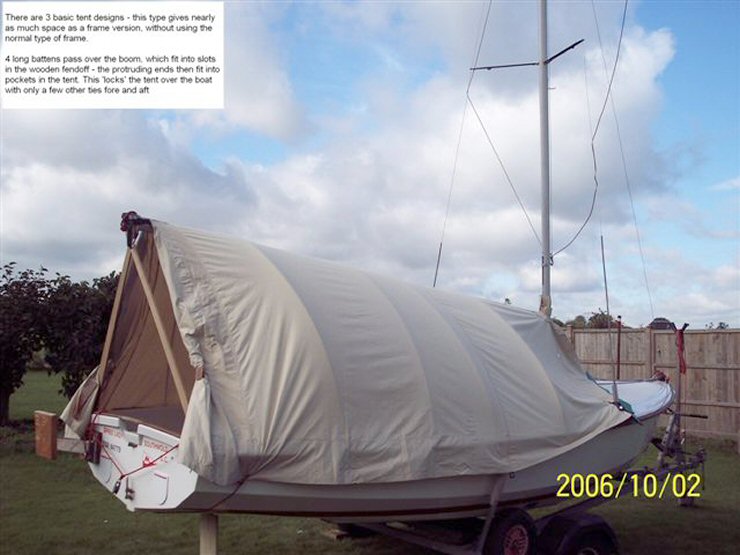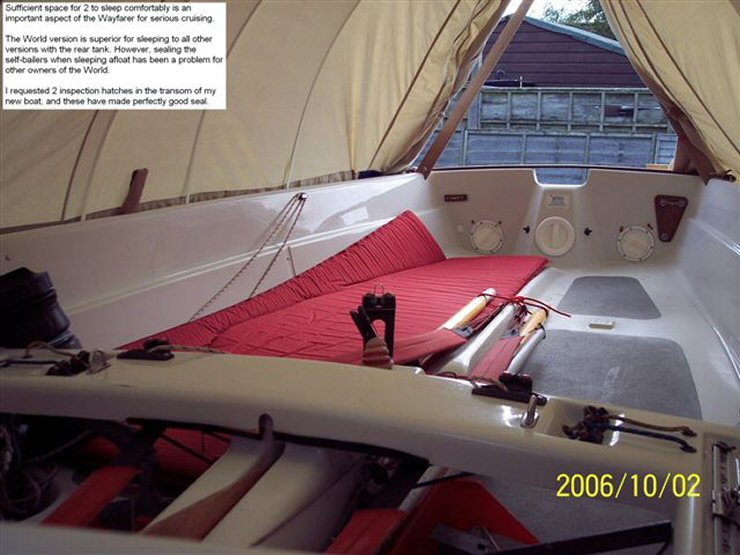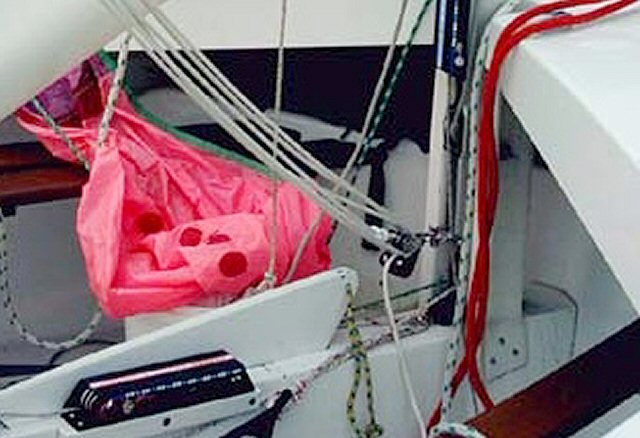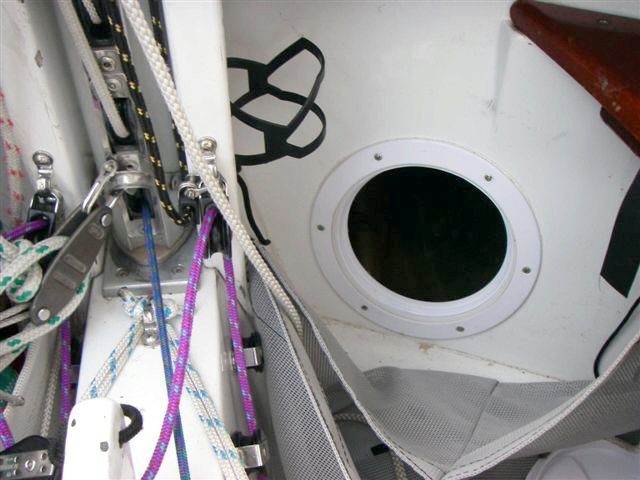| Subject:
Can I sleep dry on a Wayfarer with a permanent
floor like the W Mark III? -----
Original Message -----
From:
Richard Watterson
To: Richard C Harrington
Cc: Tom Graefe ; ... ; uncle-al3854@cogeco.ca
Sent: Tuesday, January 16, 2007 10:30 PM
Subject: Sleeping
dry?
I wanted to get some input on an idea I have. My Wayfarer does not have the floorboard arrangement which will make it kind of bad seeing as how it is almost impossible to get every little bit of water out or keep it out should it be raining and running down the mast etc. Instead of being above the little bit of water that might seep in I would be lying right in it. I was wondering about constructing a set of floorboards to keep us up out of the slop. What do you think? Richard Watterson -----
Original Message -----
From:
Al Schonborn
To: Richard Watterson ; Richard C Harrington
Cc: Ralph Roberts ; Tom Graefe ; Jim Fraser
W8328
Sent: Tuesday, January 16, 2007 11:04 PM
Hi, Richard:
I have copied Jim
Fraser (Nova Scotia cruiser extraordinaire!) who sails a Mk III to see
what he can contribute. Though I think he mostly sleeps in a tent on
shore. Will copy Ralph Roberts in England, also, who sails a Wayfarer
World that has a floor similar to yours as I recall. Ralph
may be away skiing for a few days though.
As I understand it, the
Mark III water flows out through the bailers even when the boat is at
rest. I have been told, I seem to recall, that the one-inch
self-inflating air mattress should keep you mostly dry. If you get too
high off the floor you might be pressed for clearance under the
thwart???
Good luck!
Uncle Al (W3854)
-----
Original Message -----
From:
Tom Graefe
To: Richard Watterson ; Richard C Harrington
Sent: Wednesday, January 17, 2007 9:14 AM
Hello Richard,
I own a Mark III and have cruised
in it a couple of times, most recently last summer in Maine for 5
days. More to the point in question, I've sailed with
plenty of spray coming on board and slept through a couple of heavy
rainstorms. Getting the water out of the boat and off the floor
has never been a problem as long as you have a decent sponge and
perhaps something like one of those synthetic chamois clothes.
The trick about keeping water out seems to be wholly a matter of
sealing the cuff around the mast. My boom tent has a gusset that
is adequate for drizzle but slowly starts to leak with a
downpour. Last summer I wrapped some self-stick tape around the
mast/cuff and that stopped it. My new plan is to take a length of
very thin latex about 2 feet by 4 inches and wrap that around where the
cuff and mast meet. I think this will solve the problem, but have
not tested it yet. By the way, this type of latex strip is eay to
find--just look for yoga or exercise equipment and find the stretch
bands. They often come in three thicknesses in a pack for about
$15. I may also try to add a different liner of closed cell foam
to the inside of the cuff itself.
I exchanged email with Jim Fraser
about this problem and he asked me to let him know if I found a
solution--he told me he often would bungi a garbage bag around the
mast/cuff: I quote from his email here:
Regarding adding floorboards, I
would shy away from that for a couple of reasons. #1 is as Al
points out--it raises the floor. Add a self-inflating air matress
on top and you are likely bumping the thwart with every move.
Reason #2 is that unless well integrated into the design they add
weight and could be cumbersome, not to mention awkward in the event of
a partial or full capsize.
Moving on to other ideas, I have
used a 'cot' I designed for sleeping aboard. It is for one side
of the boat only, and not specifically designed for avoiding water on
the floor, but really to make more room at night. That is, the
space under the cot becomes storage and also puts the two people on
different levels giving each more room. The cot is OK, and
very comfortable with an air mattress on top, though I continue to look
for improvements to help ease set-up and take-down. It consists
of two extendable tent poles for the side supports and some 1.25 inch
pvc for legs and cross supports. The deck is home sewn from
poplin type material. It rests on the rear lip that would support
the rear seats (I do not use them) and the thwart. It's about 25"
wide and 73" long, with taller folks spilling a bit onto the rear
compartment. I'd not be inclined to put one on both sides,
because it would make moving about the boat awkward, hence my ongoing
concern for keeping the deck dry. There are collapsible cots one
can buy, but they would require rework to get their frame and deck to
fit the space available on either side of the centerboard trunk.
If you get interested in this I can send you pictures.
If you are really handy with
aluminum, I suspect you could improve my design...it's on my list this
spring to make another go at some changes...but as always, the main
thing is to get out on the boat sailing, and find expedient solutions
even if not exactly perfect.
If you have any other questions
about the Mark III for cruising send them along. I am sure you
got a great intro to cruising, sailing with Dick last year, and
most of his system transfers fine, but there are a few differences due
to boat design.
Regards,
<>Tom
Graefe W9668-----
Original Message -----
From:
Richard C Harrington
To: Richard Watterson
Sent: Wednesday, January 17, 2007 9:35 PM
Richard,
Tom Graefe has the best handle on this
question. I've never had to deal with it. My thinking is
that the best solution will assume that regardless what you do, you're
going to get some water coming into the boat. In a warm
environment, such as the Chesapeake, I usually want to have the
forward and aft windows open for ventilation even if it is raining, so
long as it's not a hard rain. Being totally closed up with no air
movement can be worse than getting a little damp. If it weren't
for the problem of so little space beneath the thwart I'd be inclined
to go with the false floor idea. Even so, I would still look into
the possibility of something like a thin plastic grating (maybe 1/2"
thick) to put down onto the floor. You'll have to make
it nonskid. If necessary you could (cautiously!) remove a
portion of the bottom lip of the thwart and not lose too much structural integrity.
I know that some of the Brits set
boards on top of the thwart and seats for sleeping. Besides
having to carry extra some stuff along, you probably want to have
a tent with plenty of head room. My simple "A" style
tent (with the boom as the ridge pole) doesn't
allow a whole lot of overhead room. Anyway, I don't like the
idea of being so high up as it puts you at, or above, the center
of gravity of the boat and if you're anchored out in any kind of a
seaway the added motion may be uncomfortable. Several times
while cruising the Chesapeake, I've gotten caught
out at anchor in strong winds where Blue Mist just skated about across
the tops of the waves in wild gyrations. Feeling
that she might flip over at any moment, I moved to the middle of
the boat got down as low down as possible. I wouldn't
in the least have wanted to be on top of the thwart.
DICK
-----
Original Message -----
From: "jim fraser"
To: <uncle-al3854@cogeco.ca>;
<Richard Watterson>; <Dick Harrington>
Cc: <Ralph Roberts>; <Tom Graefe>; etc.
Sent: Saturday, January 20, 2007 2:40 PM
I always camp aboard my Wayfarer when cruising single-handed. Water flows back into the Wayfarer through the "self-bailing" scuppers when I am at anchor with gear aboard. I use a thick Therma-Rest inflatable mattress to keep above any dampness on the floor. I carry at least two sponges in case of losing one. Most dampness seems to come from water seeping down the mast and Tom Graefe has been looking into a better seal for this spot. My canvas tent has only leaked twice elsewhere, once when I rubbed on it several times in a continuous rain, and once when a deluge from a tropical storm went clear through the whole tent. I am sure some Brits have fabricated sleeping platforms to lay on top of the thwart. I have seen photos of hammocks slung from the boom and a variety of high-sided boom-tents that give more room to change the sleeping accomodation than my low-sided tent allows. Best wishes Jim From: Richard Watterson To: jim fraser Date: Sat, 20 Jan 2007 15:51:43 -0500 Jim; Thanks for sharing this with me. How thick is your inflatable mattress? Richard Watterson -----
Original Message -----
From: "jim fraser"
To: <Richard Watterson>
Cc: <uncle-al3854@cogeco.ca>
Sent: Sunday, January 21, 2007 8:47 AM
I use a Therm a Rest inflatable mattress that is 2" thick, 25"wide, and 77" long. The particular model I own isn't on the Therm a Rest web-site but the Trail Comfort model looks the same. These mattress dry out quickly in a breeze or sunshine and I find them durable. We have two identical mattresses and use them for land camping also. Neither one has failed in over 10 years of steady use. Some cheaper brands are prone to leaking. Also, I like to roll the boom tent halfways back from the stern to give me some headroom, yet still offer shelter from the wind. Then I bend the mattress in half and sit on one half while using the other half as a back rest against the thwart or rear bulkhead. I can enjoy the views in comfort, using the mattress as a chair. You should check how much room you'll have beneath the thwart with the mattress and the sleeping bag you use. I am thin and don't have a problem but a larger person might find rolling over awkward. Best wishes Jim Richard: I just thought of something I should have mentioned. I never use the rear bench seats which were issued with the boat. I find there is more room for cruising without them. If you are using the seats, the support to the floor may get in the way of the mattress. One point I made will be confusing to a reader. When I mentioned water will flow back into the Wayfarer through the "self-bailing" scuppers, I meant if they are left open as you had suggested earlier. I believe the Wayfarer Mark III was designed so they could be left unattended at a mooring and they would drain themselves through the open scuppers. Once gear and crew are aboard, there is enough weight to cause water to flow back into the boat, instead. I always have the bailers closed at anchor and they have never leaked. If this sounds more confusing than ever, then perhaps I have the qualifications to become a member of the provincial legislature in Nova Scotia. Jim -----
Original Message -----
From:
Ralph Roberts
To: Richard Watterson ; Al
Schonborn
Cc: Tom Graefe ;... ; Jim Fraser W8328 ; Richard
C Harrington
Sent: Sunday, January 21, 2007 3:08 PM
Subject: Sleeping
aboard a Wayfarer
Richard:
As a follow-up to Jim's
reply, my self-bailers are water-tight (or they are when I make
sure they are closed properly!), so I don't find it a problem sleeping
on the floor of my 'World' model, and would suggest that the easiest
solution would be to renew the seals, or whatever necessary to make
yours watertight when closed. An alternative sleeping position is
to lay some boards over the front and rear seats (and thwart), in
order to extend their width, using the solid watertight containers
for carrying gear to assist supporting the boards (assuming the
containers happen to be the right height - which mine were when I had
my Mk2 Wayfarer). This does give the advantage of not having to worry
about water coming in and allows gear to be stored on the floor beneath
the sleeping boards, but does mean carrying the extra gear of the
boards when cruising. I have no knowledge of using a
hammock system for sleeping in a Wayfarer.
The easiest and most effective
way of sealing the mast hole of the tent is to have a fairly long strap
of material on the collar of the tent where it fits around the mast,
and wrap this tightly around the mast. By having the soft part of the
Velcro stitched to the outside of the strap before the end, and the
nylon hooks part of the Velcro stitched to the inside of the strap
at the very end, after a couple ot turns around the mast, the Velcro
should be aligned to meet up and hey presto, a simple and very
effective way of (virtually) sealing the tent around the mast. I will
try to e-mailing you a picture (photos
below) of my tent, which provides good space within, without
carrying about the normal framework for the extra space provided by a
frame tent. The wording on the photo taken inside the boat
tent refers to the self-drainers fitted on the transom of the
boat, which is not applicable to the Abbott Mk 3 design.
Please get back to me if any follow up is needed, or there
are any further queries concerning Wayfarer cruising. Best wishes,
Ralph  Caption: There are three basic tent designs - this
type gives nearly as much space as a frame version without using the
normal type of frame. Four long battens pass over the boom. These fit
into slots in the wooden fend-off. The protruding ends then fit into
pockets in the tent. This 'locks' the tent over the boat with only a
few other ties fore and aft.
 Caption: Sufficient space for 2 to sleep
comfortably is an important aspect of the Wayfarer for serious
cruising. The World version
is superior for sleeping, to all other versions with the rear tank.
However, sealing the self-bailers when sleeping afloat has been a
problem for other owners of the World. I requested two inspection hatches in the
transom of my new boat, and these have made a perfectly good seal.
...
|
| Subject: more thoughts on sleeping
dry in a Mark III ----- Original Message ----- From:
"HAILL Andrew -THUNDER BAY"
To:
"Al Schonborn" <uncle-al3854@cogeco.ca>
Sent:
Friday, January 26, 2007 4:20 PM
Subject:
Mk III camping floor water
problem
Al I read with some interest the boom tent problem particular to the W mk III of water ingress onto the sleeping floor when it rains. As had been noted, the trick is not letting it in. However, if that is less than successful, then controlling it afterwards is necessary. Although I have not personally tried this idea, I put it out for consideration. The mast is stepped on top of the centreboard case structure which extends to the front bulkhead as shown in the pictures below. If one took some adhesive rubber strip (similar to that used on the rear hatch) and positioned it along the edges of the centreboard case from mast partner edge to the front bulkhead and also aft and narrowing towards the slot in the centreboard case, any water running along or inside the mast would be contained and pooled on top of the centreboard case and have no outlet but for the board opening where it would go down the slot and back to the lake. One might want to caulk seal the strip ends to the partner and it might even be possible to achieve this with one longish U-shaped piece running around the mast step and back to the case slot. In any case if the water is diverted to the slot by some type of dam before it runs over the edge and hits the floor, it can't produce soggy sleeping bags. cheers, Andrew Haill W9657 Thunder Bay   -----
Original Message -----
From: "Al Schonborn" <uncle-al3854@cogeco.ca>
To: "HAILL Andrew -THUNDER BAY"
Sent: Friday, January 26, 2007 11:25 PM
Thanks. Posted at http://www.wayfarer-international.org/WIT/cruise.daysail/boom.tent/permanent.floor.html and will also appear in Monday's Weekly Whiffle. My only concern would be the durability factor. Uncle Al (W3854) -----
Original Message -----
From: "HAILL Andrew -THUNDER BAY"
To: "Al Schonborn" <uncle-al3854@cogeco.ca>
Sent: Monday, January 29, 2007 8:52 AM
Yeah, I wondered about that, too, and the attachment for the hiking straps might compress the rubber strip a bit, too. Plastic strips glued to the top of the case would be a more permanent solution. Of course one only needs this when camping, so reinstalling a rubber strip once a year would not be a big deal if there is some durability issues. A modifications or two might produce a better system, but the principle of creating a dam of some sort should solve the water onto the floor problem. Andrew -----
Original Message -----
From:
Al Schonborn
To: HAILL Andrew -THUNDER BAY
Sent: Monday, January 29, 2007 8:04 PM
Hi, Andrew:
Or, now that I think of
it, you could move the hiking straps attachment points
to where we have them on W3854, one on each (out)side
of the mast step partners? That, too, would leave you free to do your
beaver imitations!!
Best regards,
Uncle Al (W3854)
|